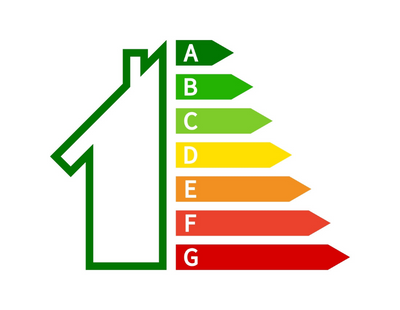
It is estimated that around 33,000 properties across the UK may be unwittingly let illegally, according to research.
A recent study exploring the risks and impacts on the reliability of Energy Performance Certificates (EPCs) has found that tens of thousands of landlords across the UK could be renting out property illegally without knowing because they have should have an energy performance certificate (EPC) rating below E.
A report by property technology firm Spec suggests that as many as 2.5 million Energy Performance Certificates (EPCs) in the UK are wrong due to inaccurate measurement standards and practices, putting many landlords at risk of inadvertently breaking the law.
According to the report, the size of a property has been recorded so inaccurately that it varies by more than 10% from the actual measurement in around a quarter of all existing EPCs.
In fact, the report claims that current measurement techniques used by Domestic Energy Assessors’ (DEA) can lead to inaccuracies regarding floor space measurements. These techniques, the report claims, have created an average discrepancy on property areas of around 8.6% - around 87 sq ft.
Since April 2016, rules have been in place across England and Wales, setting out minimum energy efficiency standards (MEES).
These regulations made it unlawful for landlords to grant a new lease for properties that have an energy performance certificate (EPC) rating below E, from 1 April 2018, unless the property is registered as an exemption.
Owners of the draughtiest homes – those rated in the worst energy bands, F and G – have been required since April to upgrade them to band E or be barred from agreeing new tenancies.
James D Marshall, founder and CEO at Spec, commented: “With the growing importance of EPCs, financially, legally and environmentally, it is crucial for owners to be aware of the effects that inaccurate property measurements could have on their EPC ratings. A property’s energy efficiency rating ranges from A-G, with G being the worst possible rating.
“We know that the government hopes to have homes in the private rented sector, and all fuel-poor homes, to be upgraded to EPC band C by 2030 under its Clean Growth Strategy. However this target currently remains fanciful due to the inaccurate measurements set in place.
“It’s also clear that property professionals must very carefully consider what services and systems their business is using. Properties being marketed with inaccurate EPCs are a legal liability both to the agents marketing them and the owners or landlord renting them.”
Want to comment on this story? If so...if any post is considered to victimise, harass, degrade or intimidate an individual or group of individuals on any basis, then the post may be deleted and the individual immediately banned from posting in future.














.jpg)







.png)






Join the conversation
Jump to latest comment and add your reply
I think you'll find about 3 million properties are being illegally let.
There are about 300000 accidental LL that do not have CTL.
Then there are about a million LL letting to HB tenants when prohibited by mortgage lenders.
Then there all those letting on a short-term basis in breach of mortgage conditions.
There is massive fraud in the PRS mostly because of stupid mortgage lender restrictions.
The other is LL breaching freeholder and insurance conditions.
.Nobody wants to know about this mass fraud as if they did they would be forced to take action.
No lender wants to enforce their conditions as it would result in mass mortgages being called in causing mass bankruptcies and a possible run on the banks as mass repossessed properties come to the market.
It is not in the interests of anyone for fraud to be detected.
Some properties are constructed in such a way that it would be almost impossible to achieve a 'C' rating, without drastic unaffordable measures being taken to comply with this.
I have two properties that were built around the 1930's and despite double glazing, cavity wall insulation and fully insulated loft etc, I just about scraped a 'C' rating.
Yep so costly is it to achieve EPC C status that many LL would do better to sell those properties now before anyone realises the difficulties in 10 years time.
This is where new-build definitely beats older rental stock like your semi.
Yet it is that older stock which provides the majority of good rental supply.
If I was to buy I would go for the best price and then I would want a further discount to cover for the costs of making the property rental compliant in 10 years time
If the discount isn't given then I walk away from the purchase.
Improving to EPC C status is far from easy and I am aware it is extremely costly and time consuming to achieve.
Mind you there could be the possibility that Govt junks the EPC requirements once the UK is out of the EU.
But certainly all the properties I see for sale are rarely EPC C status.
Mostly D.
Currently there is no requirement for a homeowner who takes in lodgers to be EPC compliant................but I suppose you never know!!
Apparently in Newcastle the Council will soon require homeowners who have lodgers to be licensed at £700 a pop!!!
Don’t know about Energy Performance Certificates it’s more uncertainty. I have a house band D the Assessor advised, to replace existing windows with new double glazing, do the cavity wall insulation, another 200mm loft insulation, new Boiler which I had done completely then another assessor came and gave me same rating as I had ‘D’. Its wonderful being a LL they are all on our case.
I know what you are saying.
Even carrying out quite a lot of improvements hardly shifts your rating in most circumstances.
I also like the suggestion assessors make to move it up to another band.
Spend £4000 plus on underground heating systems etc and the annual saving to the tenant comes out at £16.00.
My understanding is that cavity wall insulation causes internal damp issues do I wouldn't have that done.
DG not allowed in conservation areas.
IWI and EWI is unsightly and very expensive so I would not have that done.
The only things I would be prepared to do and this applies to most properties.
So new boiler.
Increased loft insulation.
LED light bulbs
DG
That is it.
If I can't achieve EPC C status then I might as well sell the property and invest in a new-build.
Or invest in a property that can be exempt.
The vast majority of properties can only achieve D status with the measures you have carried out.
Anything more seems to require major structural changes which I would not be prepared to countenance.
This will mean millions of rental properties would become unlettable.
We even have the barmy Tories wanting to ban gas boilers.
Won't concern me though as I will have left the PRS years before.
EPC D status seems to be about the maximum most housing stock can achieve with relatively simple measures.
That should be the most that is required.
Had I been you I reckon I would have sold the property rather than improve to D status.
It will take years to get payback on the expenditure.
In 10 years time without EPC C status being achieved the property becomes unlettable!
I have CWI in two properties and as long as the cavity is clean when it is inserted, then there are few problems.
I have not experienced any problem with mine and it has been in over 5 years now.
Maybe but there are plenty of double in Conservation Area’s perhaps more apply to listed buildings. This particular insulation don’t transmit moisture or capillary, stock bricks outside, London brick internally. So now I understand Premier May has thrown her hat into the ring to scrap what’s left of s21 for good measure to go along with labour, Citizens Advice, Shelter, University of York, every Local Authority in the land backed up by the Courts with any excuse to spot us using it, Tenants groups now emerging. How can any business survive this, to be targeted so unfairly by so many, just for providing quality affordable property to millions of people at no cost to the State. What’s going on here ???
It’s all very well to say sell and buy a more modern one. The reality is very different, when you sell the capital gains takes a lump out so you won’t have enough money left to do anything as I know to my cost when I wanted to sell in one area & get one nearer to base. They wouldn’t allow to roll over Capital Gains, which now I understand is 28%, no indexation, taper or inflation relief. There are now waiting at Cemetery Gate for Inheritance tax. Why bother.
Yep entirely agree with what you state.
Why bother indeed!?
Well I have made my decision and indeed won't be bothering.
I plan a slow exit with hopefully sufficient combination of cash and mortgage to obtain a residential property.
Then using lodgers as replacement tenant income.
I am simply not prepared to be corralled into becoming a de facto social housing LL at my cost.
CGT is of course the rather big elephant in the room.
Fortunately I didn't gear up on equity and such is the very poor performance of values I doubt I will need to pay any CGT.
Plus I am establishing use as a Residential property before I sell each one.
But yes I'm on my way out of the industry.
So that will be 14 homeless tenants.
Not my fault.
I could have stayed in for another 13 years when my mortgages expired.
Not going to though.
I have had enough of being dictated to by all and sundry.
S24 is the main driver behind my getting out.
The most ridiculous tax ever invented with the possible exception of the Window Tax!
"I am establishing use as a Residential property before I sell each one"
You can only claim CGT exemption for the time you used the property as your primary residence (minus any allowances). So if you rented a property for 9 years and lived in it for 1 year as your primary residence, then you pay CGT on 90% of the gain. If you have more than one lodger then you only get partial CGT relief on your residence as it is classed as commercial use.
I own a mixture of Victorian terrace houses and 1930-1960's houses with 1 1990's one. I've upgraded to EPC C on the newer ones as CWI, topping up loft lagging, new boilers and radiators with temperature control valves and room thermostats, energy saving light bulbs, and double glazing. The Victorian terrace houses are all EPC D and it would take internal wall insulation and underground insulation to achieve EPC C. I know for a fact the way these houses were built this would undermine their damp proofing. I'm not doing it. The tenants would save £23 per year I'd rather just let them pay £23 less and not gain damp issues. My worry is Labour will put it back on agenda. Why can't they just say all housing push up to a EPC D standard to include owner occupiers too?
Please login to comment